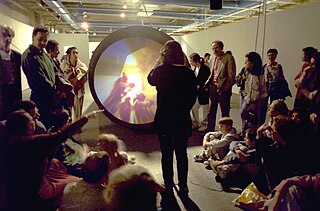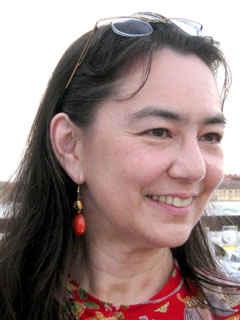
Interactive art is a form of art that involves the spectator in a way that allows the art to achieve its purpose. Some interactive art installations achieve this by letting the observer walk through, over or around them; others ask the artist or the spectators to become part of the artwork in some way.

Manfred Mohr is a German artist considered to be a pioneer in the field of digital art. He has lived and worked in New York since 1981.
Knowbotic Research is a German-Swiss electronic art group, established in 1991. Its members are Yvonne Wilhelm, Christian Hübler and Alexander Tuchacek. They hold a professorship for Art and Media at the University of the Arts in Zurich.

Peter Weibel was an Austrian post-conceptual artist, curator, and new media theoretician. He started out in 1964 as a visual poet, then later moved from the page to the screen within the sense of post-structuralist methodology. His work includes virtual reality and other digital art forms. From 1999 he was the director of the ZKM Center for Art and Media Karlsruhe.

The ZKM | Center for Art and Media Karlsruhe, a cultural institution, was founded in 1989 and, since 1997, is located in a former munitions factory in Karlsruhe, Germany. The ZKM organizes special exhibitions and thematic events, conducts research and produces works on the effects of media, digitization, and globalization, and offers public as well as individualized communications and educational programs.
New media art journals are academic journals covering the topic of new media art. They can be published in physical or online format and typically include original research, interviews, and information about books, events and exhibitions that incorporate technology in the arts.

Mary Flanagan is an American artist, author, educator, and designer. She pioneered the field of game research with her ideas on critical play and has written several books. She is the founding director of the research laboratory and design studio Tiltfactor Lab and the CEO of the board game company Resonym. Flanagan's work as an artist has been shown around the world and won the Award of Distinction at Prix Ars Electronica in 2018.
Dennis Del Favero is an Australian artist and academic. He has been awarded numerous Artist-in-Residencies and Fellowships, including an Artist-in-Residence at Neue Galerie Graz and Visiting Professorial Fellowship at ZKM Center for Art and Media, Karlsruhe. He is an Australian Research Council Laureate Fellow, Scientia Professor of Digital Innovation and executive director of the iCinema Centre for Interactive Cinema Research at the University of New South Wales; Visiting professor at IUAV, Venice; Member of the editorial board of Studio Corpi's Quodlibet, Rome; and former executive director of the Australian Research Council | Humanities and Creative Arts (2015–2016).
Jeffrey Shaw is a visual artist known for being a leading figure in new media art. In a prolific career of widely exhibited and critically acclaimed work, he has pioneered the creative use of digital media technologies in the fields of expanded cinema, interactive art, virtual, augmented and mixed reality, immersive visualization environments, navigable cinematic systems and interactive narrative. Shaw was co-designer of Algie the inflatable pig, which was photographed above Battersea Power Station for the 1977 Pink Floyd album, Animals.
Blast Theory is a Portslade-based artists' group, whose work mixes interactive media, digital broadcasting and live performance.

New media art includes artworks designed and produced by means of electronic media technologies, comprising virtual art, computer graphics, computer animation, digital art, interactive art, sound art, Internet art, video games, robotics, 3D printing, and cyborg art. The term defines itself by the thereby created artwork, which differentiates itself from that deriving from conventional visual arts. New Media art has origins in the worlds of science, art, and performance. Some common themes found in new media art include databases, political and social activism, Afrofuturism, feminism, and identity, a ubiquitous theme found throughout is the incorporation of new technology into the work. The emphasis on medium is a defining feature of much contemporary art and many art schools and major universities now offer majors in "New Genres" or "New Media" and a growing number of graduate programs have emerged internationally. New media art may involve degrees of interaction between artwork and observer or between the artist and the public, as is the case in performance art. Yet, as several theorists and curators have noted, such forms of interaction, social exchange, participation, and transformation do not distinguish new media art but rather serve as a common ground that has parallels in other strands of contemporary art practice. Such insights emphasize the forms of cultural practice that arise concurrently with emerging technological platforms, and question the focus on technological media per se. New Media art involves complex curation and preservation practices that make collecting, installing, and exhibiting the works harder than most other mediums. Many cultural centers and museums have been established to cater to the advanced needs of new media art.

Tamiko Thiel is an American artist, known for her digital art. Her work often explores "the interplay of place, space, the body and cultural identity," and uses augmented reality (AR) as her platform. Thiel is based in Munich, Germany.

Marc Lee is a Swiss new media artist working in the fields of interactive installation art, internet art, performance art and video art.

Ars Electronica Linz GmbH is an Austrian cultural, educational and scientific institute active in the field of new media art, founded in Linz in 1979. It is based at the Ars Electronica Center (AEC), which houses the Museum of the Future, in the city of Linz. Ars Electronica's activities focus on the interlinkages between art, technology and society. It runs an annual festival, and manages a multidisciplinary media arts R&D facility known as the Futurelab. It also confers the Prix Ars Electronica awards.
Media art history is an interdisciplinary field of research that explores the current developments as well as the history and genealogy of new media art, digital art, and electronic art. On the one hand, media art histories addresses the contemporary interplay of art, technology, and science. On the other, it aims to reveal the historical relationships and aspects of the ‘afterlife’ in new media art by means of a historical comparative approach. This strand of research encompasses questions of the history of media and perception, of so-called archetypes, as well as those of iconography and the history of ideas. Moreover, one of the main agendas of media art histories is to point out the role of digital technologies for contemporary, post-industrial societies and to counteract the marginalization of according art practices and art objects: ″Digital technology has fundamentally changed the way art is made. Over the last forty years, media art has become a significant part of our networked information society. Although there are well-attended international festivals, collaborative research projects, exhibitions and database documentation resources, media art research is still marginal in universities, museums and archives. It remains largely under-resourced in our core cultural institutions.″

Franz Fischnaller is a new media artist and transdisciplinary researcher. He is recognized for the creation of his digital, virtual reality and interactive art installations works across the fields of art, technology, humanities and cultural heritage.

Michael Bielicky is a Czech-German artist working in new media, video art, and installations. He is a professor in the department of digital media and post-digital narratives at the Karlsruhe University of Arts and Design. In 1989, Bielicky's artwork Menora/Inventur became his first work to be acquired by the ZKM Center for Art and Media Karlsruhe by its founder Heinrich Klotz.
Monika Fleischmann is a German research artist, digital media scientist, and curator of new media art working in art, science, and technology. Since the mid-1980s she has been working collaboratively with the architect Wolfgang Strauss. As part of their research in New Media Art, Architecture, Interface Design and Art Theory, they focus on the concept of Mixed Reality, which connects the physical with the virtual world.

Eku Wand is a German Designer and Multimedia director. Wand is a professor of media design and multimedia at the Braunschweig University of Art with a research focus on Interactive Storytelling.












